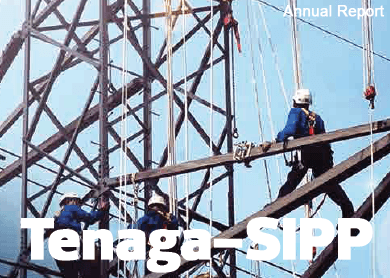
OVER the past four years, competitive bidding in the power sector reduced electricity tariffs and the internal rate of return (IRR) of power projects. However, Tenaga Nasional Bhd and SIPP Energy Sdn Bhd’s power project, which was awarded on a direct basis last year, has submitted one of the most expensive levelised tariffs in recent times.
According to industry sources, the Tenaga-SIPP consortium last month proposed a levelised tariff of 39 sen per kWh for the 1,100mw to 1,400mw combined cycle gas turbine (CCGT) power plant, also known as Project 4A, to the Energy Commission (EC). Following the direct award, Tenaga-Sipp then has to prepare a submission to the EC on the technical specifications of the plant, as well as the proposed levelised tariff, for final approval.
At 39 sen per kWh, this is about 12% more expensive than the 34.7 sen per kWh tariff that Tenaga proposed in the competitive tender for the 1,071mw CCGT power plant in Prai, which is currently under construction.
Estimated to cost between RM8 billion and RM13 billion, Project 4A was originally awarded directly to a consortium consisting of YTL Power International Bhd, SIPP and Tenaga on May 27 last year. YTL Power subsequently withdrew from the project.
The EC awarded Project 4A on a direct basis because it wanted to fast-track construction. However, there was one caveat — the power plant’s levelised tariff must be comparable to that of Tenaga’s for the Prai CCGT power plant. This was to ensure that even if the project were directly awarded, tariffs could be kept at competitive levels to prevent additional costs from being passed on to consumers.
The ball is now in the EC’s court, as it will have to decide whether to accept or reject Tenaga-SIPP’s submission. However, given the pressing need to plant up, the EC might not have the room it needs to reject the submission, notes an industry veteran.
The country’s power sector is anticipating a shortage of power around 2018, exacerbated by the massive delay in Project 3B — the 2,000mw coal-fired power plant that was awarded to 1Malaysia Development Bhd (1MDB). In fact, the EC recently announced that it will be extending the concessions of YTL Power’s Pasir Gudang and Paka CCGT power plants, which have a combined capacity of 1,200mw.
When contacted, Tenaga and SIPP declined to comment. SIPP is 51%-controlled by Sultan of Johor Sultan Ibrahim Sultan Iskandar.
Although the tariff for Project 4A looks high on paper, Tenaga’s shareholders might not see the benefits as the actual IRR of the project might be quite low and comparable to that of the Prai power plant. The low IRR could be used by Tenaga-SIPP to justify its higher tariff to the EC.
A low IRR means Tenaga and SIPP’s costs are high, caused by higher interest rates and the substantially weaker ringgit. One of the conditions imposed on Project 4A is that the selection of an engineering, procurement and construction (EPC) contractor must be done through a competitive tender process. Thus, there is no way for Tenaga-SIPP to inflate its costs to book a high project margin.
“The main difference between Prai and Project 4A is that Tenaga wholly owns Prai. Tenaga, on its own, is able to borrow cheaply because it commands a very good rating for its debts. However, as a consortium, the cost of debt would be much higher because it [the consortium] would not be able to command a similar rating,” notes an industry player.
He points out that the EC should have been aware of this fact and expected a higher tariff when it awarded the project to the consortium.
 It should be noted that Tenaga’s bid for Prai was also very competitive. Industry players estimate that the IRR for the Prai plant would have been only marginally higher than the project’s cost of debt. In fact, it would almost certainly be lower than the estimated 7.5% IRR cap that Tenaga is allowed for its regulated assets — transmission and distribution — which are essentially monopolies with low risk.
It should be noted that Tenaga’s bid for Prai was also very competitive. Industry players estimate that the IRR for the Prai plant would have been only marginally higher than the project’s cost of debt. In fact, it would almost certainly be lower than the estimated 7.5% IRR cap that Tenaga is allowed for its regulated assets — transmission and distribution — which are essentially monopolies with low risk.
Complicating matters is the apparent strained relations between Tenaga and SIPP. Both parties took a long time to finalise the equity structure of the project, with earlier reports suggesting that Tenaga had been prepared to walk away from the project at one point.
The disagreements are said to have contributed to the consortium’s delay in submitting documents to the EC. The consortium had applied for an extension of two months for the submission of documents.
Nonetheless, Project 4A is not behind schedule as Tenaga and SIPP have until October to complete the financial close. However, that doesn’t give the EC much room to reject the submitted tariff, even if it is a little high. With the delay at Project 3B, the EC is once again in a tough spot. To keep the lights on, it might have to approve tariffs that are higher than it would have preferred and, ultimately, the consumer will have to foot the bill, says a power industry executive.
This article first appeared in The Edge Malaysia Weekly, on April 6 - 12, 2015.
Save by subscribing to us for your print and/or digital copy.
P/S: The Edge is also available on Apple's AppStore and Androids' Google Play.